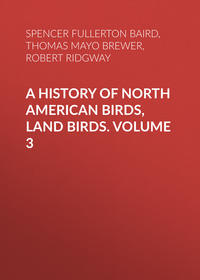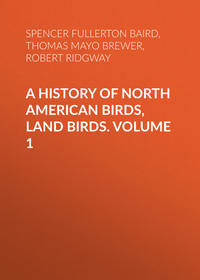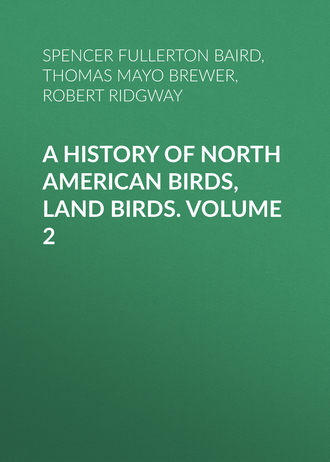 полная версия
полная версияA History of North American Birds, Land Birds. Volume 2
Wing, 1.35; tail, 1.00 to 1.10; bill, .42. Continuous green above; gorget not brilliant, but with a dusty appearance. Tail less graduated. Hab. Costa Rica and Chiriqui … var. scintilla.117
Selasphorus rufus, SwainsonRUFOUS-BACKED HUMMING-BIRDTrochilus rufus, Gmelin, Syst. Nat. I, 1788, 497.—Aud. Orn. Biog. IV, 1838, 555, pl. ccclxxii. Selasphorus rufus, Swainson, F.-Bor. Am. II, 1831, 324.—Aud. Birds Am. IV, 1842, 200, pl. ccliv.—Baird, Birds N. Am. 1858, 134.—Cooper & Suckley, 164.—Dall & Bannister, Trans. Chicago Acad. I, 1869, 275 (Alaska).—Finsch, Abh. Nat. III, 1872, 29 (Alaska).—Cooper, Orn. Cal. 1, 1870, 355. Trochilus collaris, Lath. (Bonaparte). Trochilus sitkensis, Rathke (Bonaparte). Ornysmia sasin, Lesson (Bonaparte).
Sp. Char. Tail strongly cuneate and wedge-shaped. Upper parts, lower tail-coverts, and breast cinnamon. A trace of metallic green on the crown, which sometimes extends over the back, never on the belly. Throat coppery red, with a well-developed ruff of the same; below this a white collar. Tail-feathers cinnamon, edged or streaked at the end with purplish-brown. Female with the rufous of the back covered or replaced with green; less cinnamon on the breast. Traces only of metallic feathers on the throat. Tail rufous, banded with black and tipped with white; middle feathers glossed with green at the end. Tail still cuneate. Length of male, 3.50; wing, 1.55; tail, 1.30.
Hab. West coast of North America, and across from Gulf of California to the Upper Rio Grande Valley, and along the table-lands of Mexico, south; in Middle Province east to East Humboldt Mountains.
Specimens from the table-lands of Mexico are smaller than those from Oregon, and have yellower, less ruby throats.
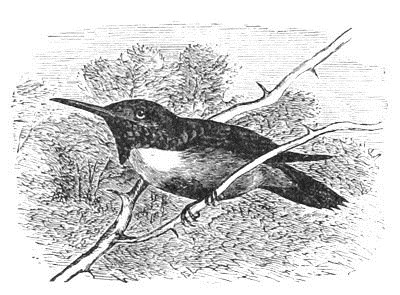
Selasphorus rufus.
Habits. This brilliant species has an extended distribution throughout the western part of North America, being found from the valley of the Rio Grande to the Pacific, and from Mexico to Sitka. It was first discovered near Nootka Sound, by that distinguished navigator, Captain Cook, and described by Latham, and has been met with as far to the south as Real del Monte, on the table-lands of Mexico, by Mr. Taylor, whose specimens were described by Mr. Swainson.
Dr. Coues found it very abundant at Arizona, near Fort Whipple, as it is also along the whole slope of the Rocky Mountains. It is a summer resident in that Territory, and breeds there abundantly, arriving at Fort Whipple April 10, and remaining until the middle of September, being found in all situations, particularly meadows, open copses, ravines, etc., where flowers are most abundant.
Mr. Dall gives them as common summer residents at Sitka. Bischoff obtained sixteen specimens. Dr. Suckley says they are very abundant in the western provinces of both Oregon and Washington Territory, and in Vancouver Island. They appear to be very hardy, and are one of the earliest of the migratory birds to arrive in spring. At Fort Steilacoom, latitude 47°, they appeared April 10. They are supposed to commence their southern migrations from that region in September,—a move induced by the scarcity of flowers and lack of means of captivating insects, rather than by cold. In Washington Territory their incubation commences about the 10th of May, and is made evident by the fierce and angry battles continually occurring between the male birds, in which they tilt at each other at full speed, at the same time keeping up a loud and vociferous squeaking and buzzing.
A nest with eggs, of this species, obtained by Dr. Cooper near Fort Slaughter, May 23, was found in the forked branch of a snowberry-bush. It was composed principally of fine green moss, lined internally with the delicate floss of the cottonwood, and externally bordered most artistically with rock lichens. The female was on the nest, and allowed so near an approach as almost to admit of being grasped by the hand. The nest was 2.00 inches in diameter and 1.50 in height. The eggs measured .45 by .33 of an inch, and were white, as in all the species.
Dr. Cooper states that the appearance of this species at the Straits of Fuca is coincident with the blossoming of the red-flowering currant, which begins to bloom on the Columbia March 10. The male of this species has a remarkable habit, when a stranger or a wild animal approaches its nest, of rising to a great height in the air, and of then darting down perpendicularly upon the intruder, producing a hollow rushing sound, like that of the Night-Hawk, but of a much sharper tone. These sounds are produced by the wings. In July, when flowers are more abundant among the mountain summits, they leave the lower country. Dr. Cooper found them abundant in August at an elevation of nearly six thousand feet, and where ice was formed at night in their camp.
In California, Dr. Cooper has not found any of this species remaining in winter, even at San Diego, where, however, he has known them to arrive as early as the 5th of February. He also saw several on the 22d of the same month feeding among the flowers of the evergreen gooseberry. By the first of April they were swarming about San Diego. Their young are hatched before the middle of June. When perching, this species is said to utter a shrill wiry call, like the highest note of a violin. They also produce a curious kind of bleating sound. They are among the most noisy and lively of their race, are very quarrelsome, chase each other away from favorite flowers, rising into the air until out of sight, chirping as they go in the most excited manner.
Mr. Lord noticed the arrival of this species at Little Spokan River, in latitude 49°, early in May. He found their nests usually in low shrubs and close to rippling streams. The females of this and other species are said to arrive about a week later than the males.
Dr. Heermann for several successive seasons found many pairs of these birds breeding in the vicinity of San Francisco.
Mr. Nuttall compares the appearance of the male birds of this species, when he approached too near their nests, to an angry coal of brilliant fire, as they darted upon him, passing within a few inches of his face as they returned again and again to the attack, making a sound as of a breaking twig.
Dr. Woodhouse, who found this bird abundant in New Mexico, particularly in the vicinity of Santa Fé, speaks of the great noise they make for so small a bird, and of their quarrelsome and pugnacious disposition.
Mr. R. Brown, in his synopsis of the birds of Vancouver Island, notes the appearance of this species, from the end of March to the beginning of May, according to the state of the season. Its nest was built on the tips of low bushes, or the under branches of trees. This was the only species of Humming-Bird seen west of the Cascade Mountains.
The Rufous Hummer was first noticed by Mr. Ridgway in the valley of the Truckee River, in August, where it was the only species shot, and was extremely abundant among the sunflowers which ornament the meadows. In May of the succeeding year, when the same locality was again visited, not one of this species was to be found, its place being apparently supplied by the T. alexandri, which was quite common, and breeding. Eastward it was met with as far as the East Humboldt Mountains, where, however, only a single pair was seen, and one of them shot, in September.
Selasphorus platycercus, GouldBROAD-TAILED HUMMING-BIRDTrochilus platycercus, Sw. Philos. Mag. I, 1827, 441 (Mexico). Selasphorus platycercus, Gould, Mon. Trochilid. or Humming-Birds, III, May, 1852.—Baird, Birds N. Am. 1858, 135, pl. xliii, figs. 1 and 2.—Cooper, Pr. Cal. Ac. 1868 (Lake Tahoe).—Ib. Orn. Cal. I, 1870, 357. Ornismia tricolor, Lesson, Colibris, 125 (no date) pl. xiv (Brazil).—Ib. Trochilide. 1831, 156, pl. lx (Mexico).—Jardine, Nat. Lib. II, 77, pl. xiii. Ornismya montana, Lesson, Trochilid. 1831, 161, pl. lxiii, adult, and 163; pl. lxiv, young (Mexico).
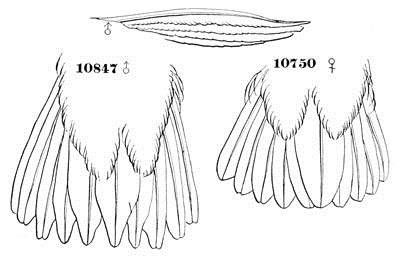
Selasphorus platycercus.
10847 ♂ 10750 ♀
Sp. Char. Outer primaries greatly attenuated at the end and turned outward. Outer tail-feathers nearly linear, but widening a little from the base; its width .20 of an inch. Tail slightly graduated and emarginate. Male above and on the sides metallic green; chin and throat light reddish-purple, behind which, and along the belly to the tail, is a good deal of white. Wings and tail dusky purplish; the tail-feathers, excepting the internal and external ones, edged towards the base with light cinnamon. Female without the metallic gorget; the throat-feathers with dusky centres. The tail somewhat cuneate, as in the male, the feathers less pointed; the outer three cinnamon-rufous at base (this extending somewhat along the outer edges), then black, and broadly tipped with white (much as in the male Atthis heloisa), the inner two feathers green, the fourth with black spot at end, and only edged at base with rufous. The sides and crissum also tinged with cinnamon. Length, 3.50; wing, 1.92; tail, 1.40. Bill, gape, .80.
Hab. Table-lands of Mexico and Rocky Mountains, and Middle Province of United States, north to Wyoming Territory. Uintah, Wahsatch, and East Humboldt Mountains (Ridgway); Sierra Nevada (Cooper); Cordova (Scl. P. Z. S. 1856, 288); Guatemala (Scl. Ibis, I, 129); Arizona (Coues, P. A. N. S. 1866, 57).
A decided character of this species among its North American relatives is the rufous outer border of the exterior tail-feathers. This rufous in S. rufus pervades most of the feathers, instead of being restricted as above. Females of the two species are not dissimilar: those of S. platycercus are larger, less rufous beneath; the tail-feathers broader and less pointed, and with the inner two (on each side) entirely green to base (the fourth edged with rufous), instead of being principally rufous, except at tip.
Specimens from Mirador, Mexico, are undistinguishable from those of Fort Bridger; those from Guatemala are smaller than the Mexican.
Habits. Until recently this Humming-Bird has been presumed to be an exclusively Mexican and Central American species. Until taken within our limits, it had been supposed to be confined on the north to the Mexican plateau, westward to the city, and thence southward to Guatemala, while throughout this region it is said to be very generally and very plentifully distributed. It was first taken, in 1851, by Mr. J. H. Clark, near El Paso, Texas. Subsequently numerous specimens were seen by Dr. Coues on the summit of Whipple’s Pass of the Rocky Mountains, in July, feeding among clumps of wild roses. It was not noticed near Fort Whipple, though the range of this species is now well known to include New Mexico and Arizona, as far north, at least, as Fort Bridger in Wyoming. It was found breeding abundantly in the vicinity of Fort Grant, Arizona, by Dr. Palmer.
This Humming-Bird was found by Mr. Allen more or less common among the foot-hills, as well as among the mountains, of Colorado, and extending several miles out on the plains. On Mount Lincoln, in Colorado, he found it exceedingly numerous, and though larger and otherwise different from the eastern Ruby-throat, it might easily be mistaken for it. The shrill whistling of its wings, he adds, is a peculiarity one is sure to notice. This Humming-Bird continued to be common on the sides of Mount Lincoln to far above the timber line, being apparently as much at home among the bright flowers growing on the highest parts of the mountain as in the valleys.
At Lake Tahoe, at an elevation of six thousand feet, Dr. Cooper found the young of this species quite common near the middle of September. Supposing them to be the more common S. rufus, he only obtained a single specimen. He thinks that these birds extend their northern migrations as far as the Blue Mountains, near Snake River, Oregon, and that they are the ones referred to by Nuttall as seen by him in autumn, and supposed to be the rufus.
The nests of this species procured by Dr. Palmer were large for the size of the bird, unusually broad and shallow, composed of soft downy pappus from seeds of plants, and vegetable down, with the outer walls covered with mosses and lichens. The eggs are not distinguishable from those of the other species.
The Rocky Mountain or Broad-tailed Hummer, according to Mr. Ridgway’s observations, is the most abundant species in the Great Basin, though he did not see it to recognize it west of the East Humboldt Mountains. It is essentially a bird of the mountains, since in that region there are few flowers elsewhere; yet in the gardens of Salt Lake City, an altitude far below its usual habitat, it was abundant. Its favorite resorts are the flowery slopes of the higher and well-watered mountain-ranges of the Great Basin and Rocky Mountain system, at an average elevation of about eight or nine thousand feet, yet it will be found wherever flowers are abundant. Mr. Ridgway saw one at an altitude of about twelve thousand feet, in July, on the East Humboldt Mountains, but it merely passed rapidly by him. In the Wahsatch Mountains, particularly in the neighborhood of Salt Lake City, this species was most plentiful. It there nested abundantly in the scrub-oaks on the hills or slopes of the cañons.
The male bird is very pugnacious, and was observed to attack and drive away an Accipiter fuscus, the Hawk retreating as rapidly as possible. When the nest is approached, the male often rises high into the air and then sweeps down almost to the head of the intruder, its swift descent being accompanied by a very peculiar shrill, screeching buzz, of an extraordinary degree of loudness to be produced by so small a creature. The same sound Mr. Ridgway noticed when the bird was passing overhead, in a manner not observed in any other species, its horizontal flight being by a peculiar undulating course. The shrill noise made by the male of this species he suggests may be caused by the curious attenuated and stiffened outer primary. He noticed a curious piece of ingenuity in nest-making on the part of this species. The nest in question was fastened upon a dead twig of a small cottonwood-tree; the loosening bark, which probably had separated after the nest was finished, had allowed the nest to turn around so as to hang beneath the branch, thus spilling the eggs upon the ground. The owners, however, built another nest upon the top of the branch, fastening its sides to that of the old one, and making the new nest lighter and less bulky, so that the weight of the older nest kept the other in a permanently upright position.
Genus ATTHIS, ReichenbachAtthis, Reich. Cab. Jour. f. Orn. extraheft für 1853, 1854. Appendix B. (Type, Ornysmya heloisa, Lesson, Del.)
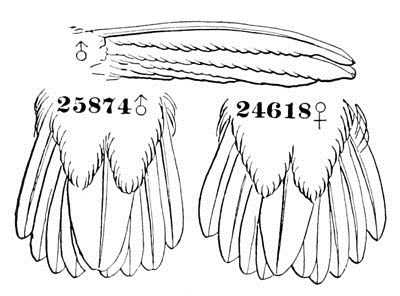
Atthis heloisa.
25874 ♂ 24618 ♀
Gen. Char. Size very diminutive; bill short, scarcely longer than the head. Outer primary attenuated nearly as in Selasphorus; the tail graduated, the feathers, however, not lanceolate-acute, but rounded at end, and tipped with white in the male.
This genus seems closely related to Selasphorus, agreeing in character of throat, the curious attenuation of outer primary, and the general shape of the tail, with its rufous base and edging. The feathers, however, are not lanceolate and pointed, either sharply as in S. rufus, or obtusely as in platycercus, but are more equal to near the end, where they round off. The white tip of the tail in the male seems to be the principal reason why Mr. Gould removes the single species from Selasphorus, where it was previously placed by him, and where perhaps it might have not inappropriately remained.
Atthis heloisa, Less. & DelHELOISA’S HUMMING-BIRDOrnysmya heloisa, Lesson & Delattre, Rev. Zoöl. 1838, 15 (Xalapa). Mellisuga heloisa, Gray & Mitchell, Gen. Birds, I, 113. Tryphæna heloisa, Bonap. Consp. Troch. Rev. Mag. Zoöl. 1854, 257. Selasphorus heloisæ, Gould, Mon. Trochil. III, pl. cxli. Atthis heloisæ, Reich. Cab. Jour. extraheft, 1853, App. 12.—Gould, Introd. Trochil. 1861, 89.—Elliot, Illust. Birds N. Am. I, xxi, XII, plate.—Cooper, Orn. Cal. 1, 1870, 361.
Sp. Char. Male. Above metallic green with golden reflections; beneath white; the sides of breast glossed with green; the flanks with rufous, which tinges the crissum very faintly; gorget brilliant violet or light purplish-red, bordered behind by clear white. All the tail-feathers rufous-cinnamon for basal half; the three outer black centrally and tipped with white (mixed with reddish on the third); the fourth green, centrally tipped with black; the central entirely green for the exposed portion, perhaps glossed with blackish at the end. Length, 2.70; wing, 1.35; tail, 1.00; exposed part of bill above, .45. Female. Outer primary not attenuated. Colors similar to male, wanting the metallic gorget; the feathers spotted with dusky; crissum and flanks more rufous; innermost tail-feathers entirely green; other feathers as in male, but with the central black encroaching on the basal rufous; third and fourth feathers tipped with reddish-white.
Hab. Southern New Mexico and Texas, to Guatemala.
The introduction of this species into the fauna of the United States is based on a female specimen collected by Mr. J. H. Clark at El Paso, Texas, and for a time supposed to be Selasphorus rufus, but after a careful examination by Mr. Lawrence, pronounced to belong to this species. Its range is southward along the highlands to Guatemala.
The species is very much like Selasphorus in shape, and hardly differs more than S. rufus and platycercus do from each other. The male is easily distinguished from its allies; the females are closely related to those of rufus, differing in much shorter bill (.55 to .65), much less rufous on the more nearly even tail, with broader feathers, etc.
Habits. This species claims a place within the fauna of North America, probably only as an accidental visitor, on the ground of a single specimen,—a female, taken by Mr. J. H. Clark at El Paso, Texas. It was at first mistaken for Selasphorus rufus. It is a Mexican and Central American species, ranging throughout the highlands at least as far to the south as Guatemala, where it was taken by Mr. Salvin.
It was first discovered on the highlands of Mexico by Mr. Delattre, who procured his specimens between Jalapa and Quatepu. It is crepuscular in its habits, collecting its food only in the morning or in the evening. Mr. Delattre states that the male bird is known to rise very early in the morning, and is never seen in quest of food later than nine in the forenoon. It very seldom goes to any distance from its mate or young, seeming to prefer to frequent the flowers in the edge of forests, but does not disdain those of the open fields. Mr. Salvin received specimens of this species taken in a place called Chimachoyo near Calderas, in the Volcan de Fuego, and other specimens taken in the tierra caliente, near Coban, showing that, like many other species, it is found in very different climates.
Genus HELIOPÆDICA, GouldHeliopædica, Gould, Mon. Trochilidæ, II, Introd. Trochil. 1861, 60. (Type, Trochilus melanotus, Swainson.)
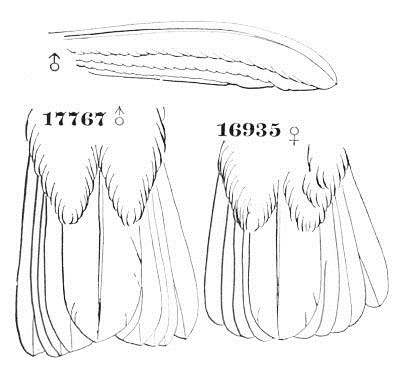
Heliopædica xantusi.
17767 ♂ 16935 ♀
Gen. Char. Bill longer than head, depressed, broad at its exposed base; the frontal feathers not advancing forward beyond the beginning of the nostrils, nor so far as those of the chin. Hind toe shorter than the lateral, tarsi feathered; outer primary not attenuated. Tail nearly even, slightly rounded and emarginate, the feathers broad, the webs nearly even. Metallic feathers of throat not elongated. Female quite similar in form.
This genus is quite peculiar among those of North America in the exposure of the base of bill, which is entirely bare between the lengthened nostrils, instead of covered by the frontal feathers. This makes the bill appear very broad, although it really is more so than in the other genera. The feathers on the chin extend considerably beyond those of the forehead, instead of to about the same line. The tail and its feathers are much broader than in the other genera.
The two known species of this genus may be distinguished by the following characters:—
Common Characters. Above metallic green; tail plain black or chestnut, glossed with green, and without white in either sex. A conspicuous white post-ocular stripe, and a blackish auricular one beneath it; beneath with more or less green. ♂. Forehead, chin, and side of head deep black or metallic dark blue; throat and jugulum brilliant green. ♀. Front dull brownish-green; chin, throat, and jugulum white or ochraceous, with or without a green gloss.
H. melanotis. 118 Male. Belly white, glossed with green; tail black beneath; base of bill, all round, brilliant blue; white cheek-stripe beginning back of the eye. Female. Beneath white glossed with green; tail bluish-black. Hab. Guatemala and table-lands of Mexico.
H. xantusi. Male. Belly cinnamon; tail beneath purplish-cinnamon; chin black; white cheek-stripe beginning at the bill. Female. Beneath plain pale rufous; tail deep rufous. Hab. Cape St. Lucas.
Heliopædica xantusi, LawrenceXANTUS’S HUMMING-BIRDAmazilia xantusi, Lawrence, Ann. N. Y. Lyc. VII, April, 1860, 109. Heliopædica xantusi, Gould, Mon. Troch. II, pl. lxv.—Ib. Introd. Troch. 61.—Elliot, Ill. Birds N. Am. XI, plate.—Cooper, Orn. Cal. 1, 1870, 365. Heliopædica castaneocauda, Lawrence, Ann. N. Y. Lyc. 1860, 145 (female).—Elliot, Illust. Birds N. Am. I, xxii.

Heliopædica xantusi.
Sp. Char. Male. Above metallic green; the forehead, cheeks, and chin velvety black (the former with a deep blue gloss). A distinct white stripe from bill, through and behind the eye. Throat and forepart of breast brilliant metallic green; rest of under parts cinnamon-rufous; all the tail-feathers purplish-rufous,—the central glossed with green above, near the edges, the others obscurely edged with blackish along ends. Bill red at base, black at end. Length, 3.50; wing, 2.10; tail, 1.40; exposed portion of bill above, .65. Female. Forehead and all under parts light cinnamon beneath, without any green, or any dusky specks on throat; white cheek-stripe appreciable, but tinged with rufous. Tail as in male, but the central feathers entirely green above, the other, except the outer, with a dusky greenish or purplish spot on each web near the end. Whole upper mandible apparently dusky; base of lower, red.
Hab. Cape St. Lucas.
This well-marked and interesting species we owe to Mr. Xantus, together with many other birds of the west coast. It is sufficiently distinct to require no comparison other than that given under the general head; it can be separated from H. melanotis in all stages of plumage by the rufous tail.
Specimens vary sometimes in the intensity of the rufous shade, and, as stated, it is probable that the forehead, instead of being black, in full plumage is deep blue, as in melanotis.
Habits. This is a new and well-marked species, and although belonging to the North American fauna cannot be claimed for the United States, having thus far been only taken at Cape St. Lucas by Mr. Xantus, and described by Mr. Lawrence in 1860. Nothing is known as to its specific habits.
Genus THAUMATIAS, BonapGen. Char. Very similar in general form to Heliopædica, but the tail emarginated, instead of rounded, the feathers narrower and less rounded at the ends. The coloration quite different. Sexes alike, in all the species. Color nearly uniform green, with the anal region white, the wings and tail dusky. Many species with the whole lower parts, except laterally, pure white. One species (T. chionurus) with the tail white, except the ends of the feathers and the intermediæ.


